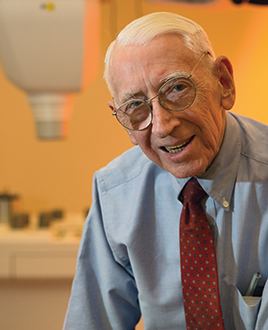Luther W. Brady Jr., M.D. ’48, B.A. ’46, A.A. ’44, HON ’04
Luther W. Brady Jr. is on the verge of a clean sweep. A three-time alumnus of the George Washington University — Associate of Arts in 1944, Bachelor of Arts in 1946, and Medical Doctor in 1948 — Brady will receive the highest honor GW President Steven Knapp can bestow, the GW President’s Medal, this spring.

The honor will share space on his shelf with a GW Society Medal, presented in 1995 by GW’s Board of Trustees; the 1991 Distinguished Alumni Achievement Award; and the highest university-wide honor available, an honorary degree, Doctor of Fine Arts. Although Brady’s shelf is full of honors and awards from various institutions, recognition from his alma mater is quite dear. “At a very critical time in my youth, GW gave me direction,” says Brady, a GW Board of Trustees Emeritus. “It embedded in me the sense of responsible action. It gave me the sense of morals and ethics. It gave me a lifetime interest in ongoing inquiry. It imbued in me the sense to innovate and to participate in research and to be a teacher.”
Brady, faculty member at Drexel University College of Medicine for more than 50 years, began his career when the field of nuclear medicine was still the Wild West. He learned his craft delivering radiation therapy using a Van Der Graaf generator the Navy originally commissioned to check steel plates for defects. Today, his clinical practice relies on the CyberKnife Robotic Radiosurgery System — technology that beams high-dose radiation with a degree of precision that could scarcely be imagined in the late 1950s. Along the evolution of his career, Brady has been instrumental in the initiation and establishment of modern radio-oncological treatments for eye tumors and cervical cancer, for which he established new standards of care.
“At a very critical time in my youth, GW gave me direction. It embedded in me the sense of responsible action. It gave me the sense of morals and ethics. It gave me a lifetime interest in ongoing inquiry. It imbued in me the sense to innovate and to participate in research and to be a teacher.” — Luther W. Brady Jr. M.D. ’48, B.A. ’46, A.A. ’44, HON ’04
World War II brought the family to Washington, D.C. from small-town Wilson, North Carolina, shortly after Brady graduated from high school at 16 years old. His father worked for the Navy Department, while his mother served as treasurer for a local bank in their newly adopted home of Bethesda, Maryland.
Brady chose George Washington and a zoology major for the start of his college education, but he had longed to study medicine since early childhood. As a toddler, Brady suffered a serious break to his upper arm after a pedal-car crash. He had it set at the local hospital under general anesthesia, “using ether if you can imagine such a thing.”
From that moment, Brady was drawn toward medicine, and he was accepted to GW’s M.D. program before earning his zoology degree. “To this day I really have no idea how I was accepted so quickly, having just started university.”
Following a research internship at the National Cancer Institute, where he worked for Harold Stewart, M.D., and Thelma Dunn, M.D., Brady was pressed into service with the United States Navy. Among his early posts was the U.S. Naval Hospital in Bethesda; there, Brady was introduced to nuclear medicine and the Van Der Graaf generator.
During his Navy service, Brady also formed a life-long affection for art. While serving on a cruiser in Long Beach, California, Brady met a collection of young artists —Richard Diebenkorn, Sonia Gechtoff, William Wiley, and Nathan Oliveira — who would become luminaries in the mid-century American art scene. “So in the remaining weeks that I was in California,” recalls Brady, “I visited their studios, and that’s how I got involved in collecting art, something I’ve been doing for the rest of my life.”
That interest provided counterbalance for Brady’s long hours spent in the laboratory, the classroom, and the clinic. The humanities, he says, have provided a means of keeping the world in perspective. “Physicians burn out quickly when they don’t have an outside interest,” Brady explains. “We get so involved with what we’re doing that we sometimes lose sight of the big picture.”
That is why, in 2001 at the opening of GW’s Media and Public Affairs building, Brady stunned the group on hand to view the “The Luther W. Brady, M.D. Collection of 20th Century Works on Paper” exhibition, by announcing that he would endow the new gallery. The endowment is emblematic of a life spent pursuing activity and experiences.
“I’m a great believer that things happen because you make them happen,” explains Brady. “You don’t always succeed of course, but nevertheless it’s not going happen because you sit behind the desk and hope it will happen. You help make something positive happen, something that’s a benefit. That’s responsible action.”



